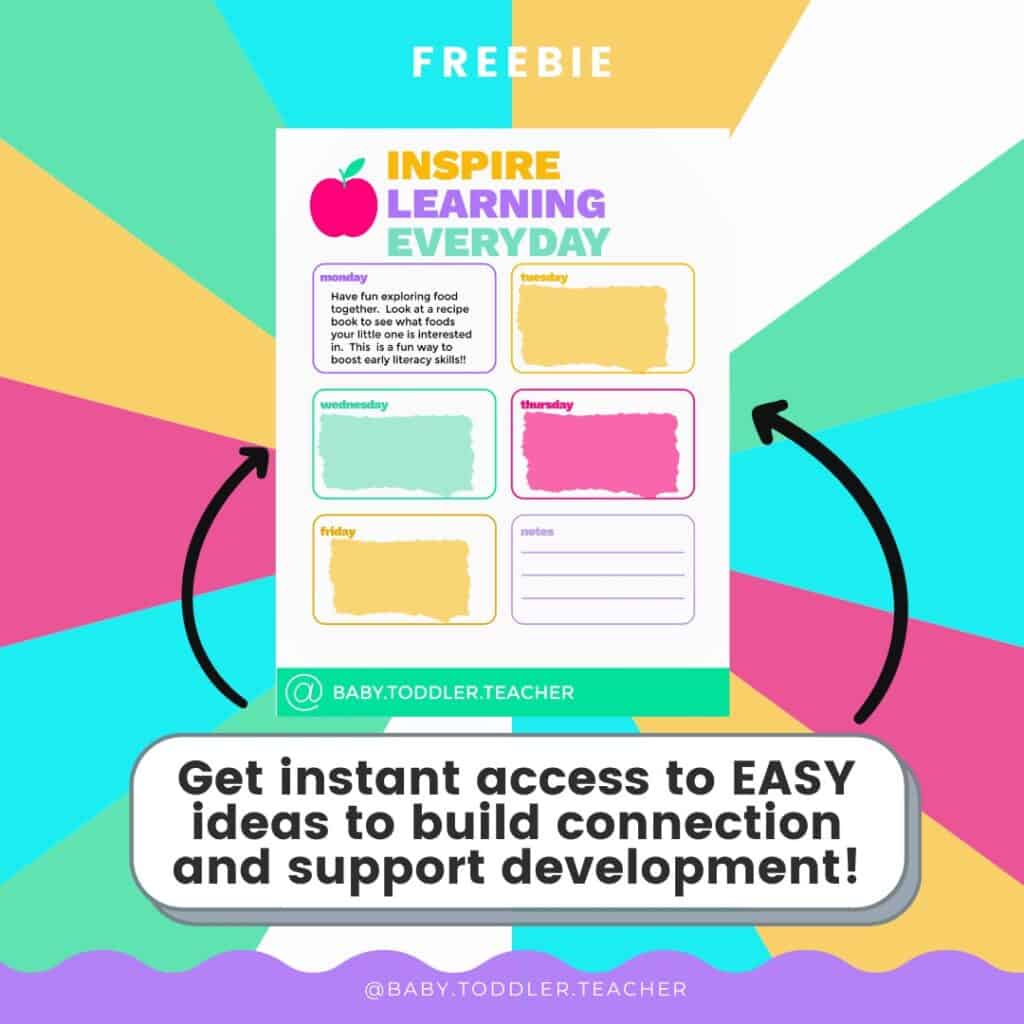One of the biggest concerns parents have about their babies and toddlers is their language development.
Encouraging language development in early childhood can be quite simple if you know the best strategies to use.
I would recommend using them frequently within your daily routines to have the most benefit.
Here are some examples of daily routines that would work well with these strategies for language development in early childhood:
- Bath time
- Diaper Changes
- Car Rides
- Grocery Shopping
- Play time
- Folding Laundry
- Feeding Your Child
- Cleaning
- Book time
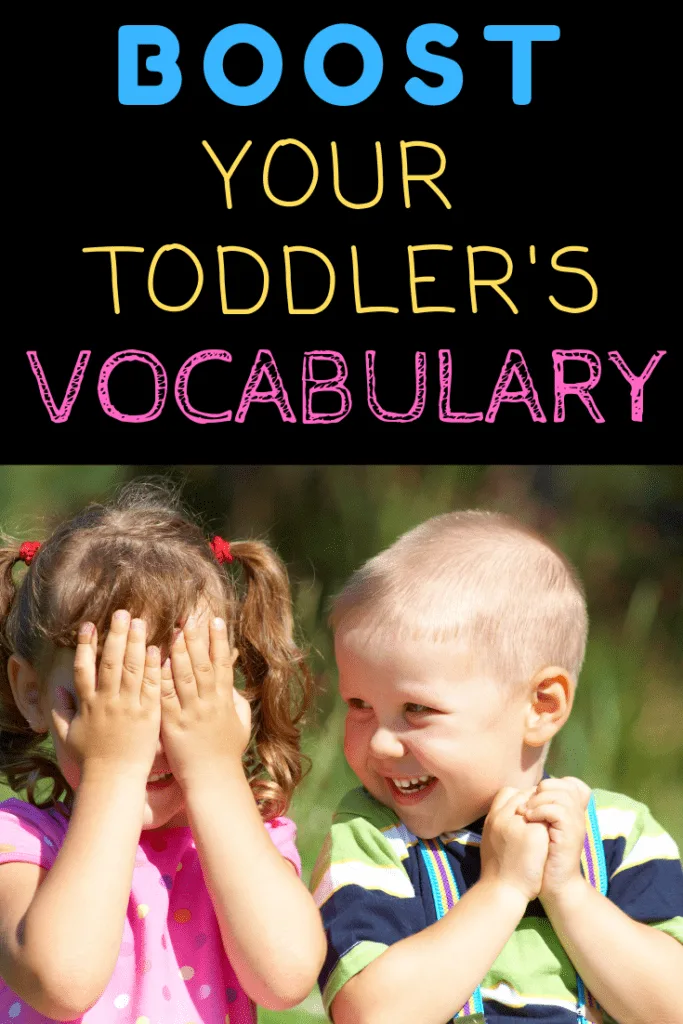
(This post contains affiliate links. To read our full disclosure policy click here.)
Strategies to Encourage Language Development in Early Childhood
One of the best ways you can support language development in early childhood is by talking to your baby from birth on up.
Narrate daily activities and singing songs can be an easy way to promote language skills everyday.
Language development allows your child to follow directions as well as express their needs and wants.
As your child learns to communicate effectively they will be less frustrated an you will most likely see a decrease in temper tantrums.
Exposure to Lots of Language: How many times does a child need to hear a word to learn it?
The number one thing you can do for your baby from birth on up is to talk to them.
Seems simple right?
Children need to hear words repeated over and over for them to be able to imitate them.
Label the objects that they desire, food they want to eat, and their favorite people again and again.
Imagine that you have decided to learn Spanish. If you were to step into a room of all Spanish-speaking people how would you learn the language?
How many times do you think you would need to hear a new word to learn it?
Now think about that from your little one’s point of view as they try to learn how to speak for the FIRST time.
Do not count on the TV for learning language….babies don’t understand it as we do!)
Providing your child with a rich language environment is the best way to encourage language development in early childhood.
This easy and excellent strategy should be at the top of your list for strategies to promote language development.
Here are 8 more effective strategies to support infant language development.
Modeling Language for Toddlers
Here are some examples of simple ways to increase the number of words your little one is exposed to everyday:
Example 1: When you are at the grocery store talk about what you see and hear. Label the items that you put in your cart. With your little one sitting right there in front of you it makes it a perfect time for them to watch, listen, and learn while you talk.
Example 2: Narrate your day. Whether you are making dinner or doing laundry, talk about what you are doing. All of your daily activities provide the perfect opportunity for your little one to learn a new set of vocabulary.
Example 3: Car time is a perfect time to talk! Describe what you are seeing as you drive. Comment on the sounds or words your child is making in the backseat. This lets them know you are listening. A 10 minute drive can turn into a wonderful language lesson.
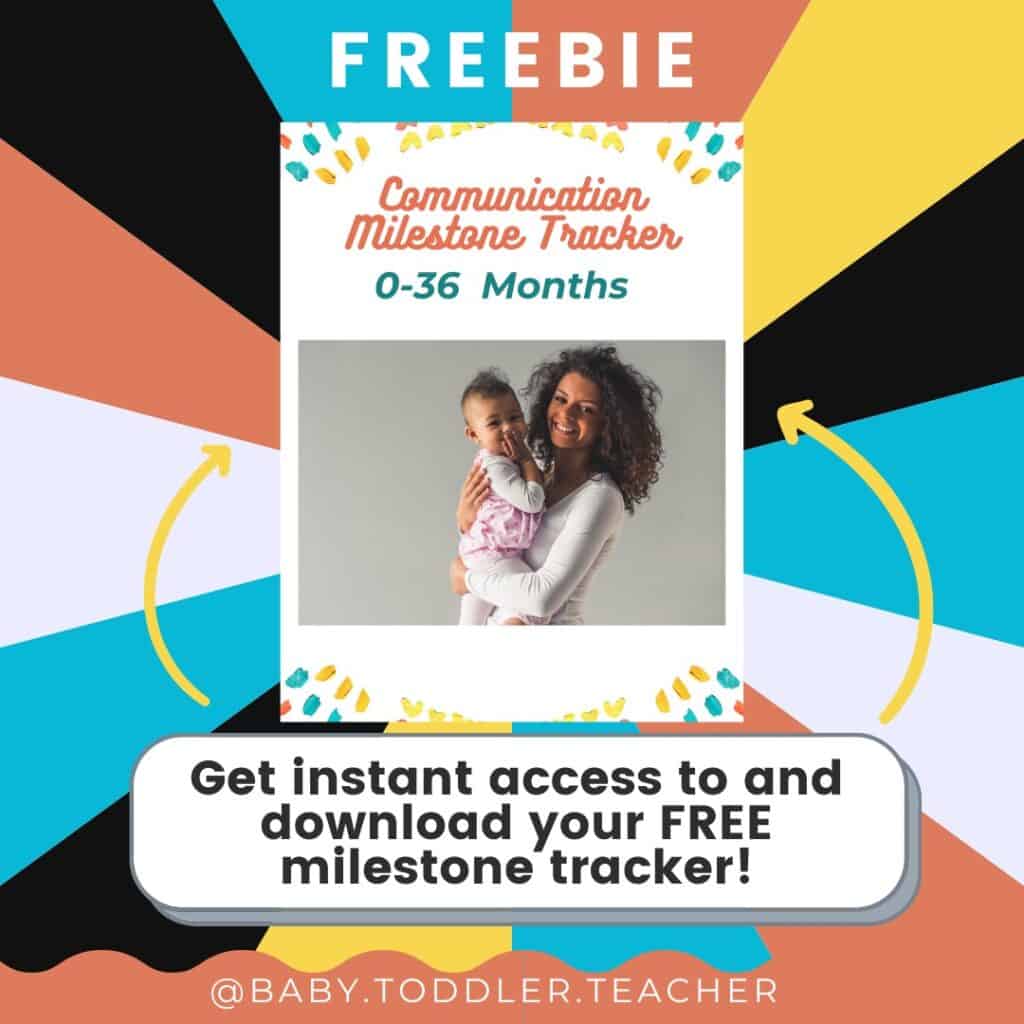
Play and Language Development Strategies in Early Childhood
Hands down children learn best through play.
What is more motivating for a child than having fun and playing?
Narrating your toddler’s play will help them learn the names of their toys and the actions that they are doing.
For example, when my son is driving his dump truck (he loves this one) I will say “go go go!” as he zooms it on the floor.
Notice that I repeat the short fun words multiple times as those are the most fun for children to imitate.
Pick three target words that you really want to focus on during a play session so your child hears those words repeated frequently.
Model Language Skills for Toddlers
When showing your little one a new object hold it right underneath your chin.
This will draw your child’s eye gaze to your mouth and help them to imitate a new word as they are watching you.
Slow down your speech while you talk to them and it will make it easier for them to understand you.
This strategy naturally draws your child’s vision up to your face which is what they need to be watching in order to imitate.
Imitation is the first step in learning language.
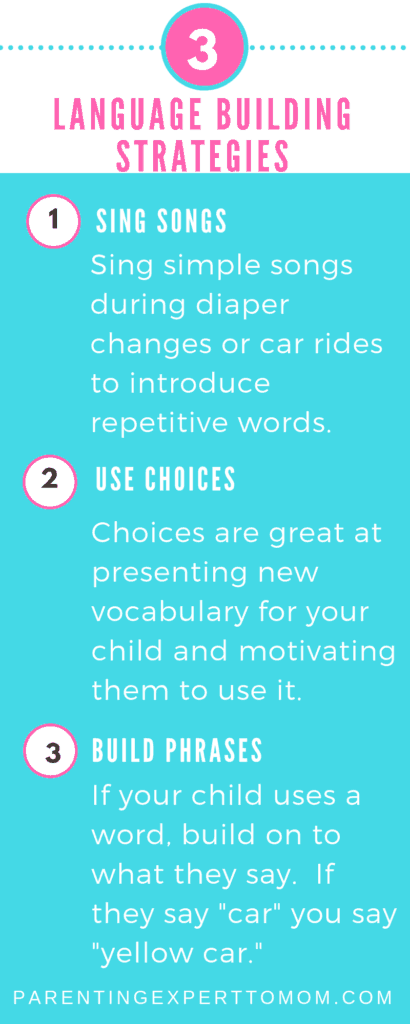
Use Choices to Increase Toddler Vocabulary
Whether it be picking out a snack or what to wear for the day give your little one the opportunity to choose.
This not only exposes your child to new words but also gives them the MOTIVATION to use their words to communicate.
Here is what it should look like: Do you want a banana or Cheerios? (by asking them you are modeling both of these words that you want to be part of their vocabulary.
If possible hold up the two items for your child to see.
WAIT.
Give them time to respond. If they point to their desired choice that’s great!
You then take that item and repeat its name-Cheerios?
WAIT.
Give them the opportunity to repeat the name. If they don’t…that’s ok!
The goal is to get your child to the point where you can ask them a simple question and they can let you know what they need or want using words.
What if your child doesn’t point to what they want?
You will need to watch their cues and their eyes to know what they want if they are not pointing yet.
Hold up the two objects and see which one they are drawn to.
They may just gaze over very quickly at it so you need to pay close attention.
Then give your child the desired choice.
Do not expect this to work the first time…or the second.
For this to be effective it needs to be done consistently and will take some practice.
Use choices when you can fit it in-mealtimes, getting dressed, or even asking what toy they want to play with next are all good opportunities.
RELATED POST: INDEPENDENT ACTIVITIES FOR TODDLERS
Building Phrases to Increase Vocabulary
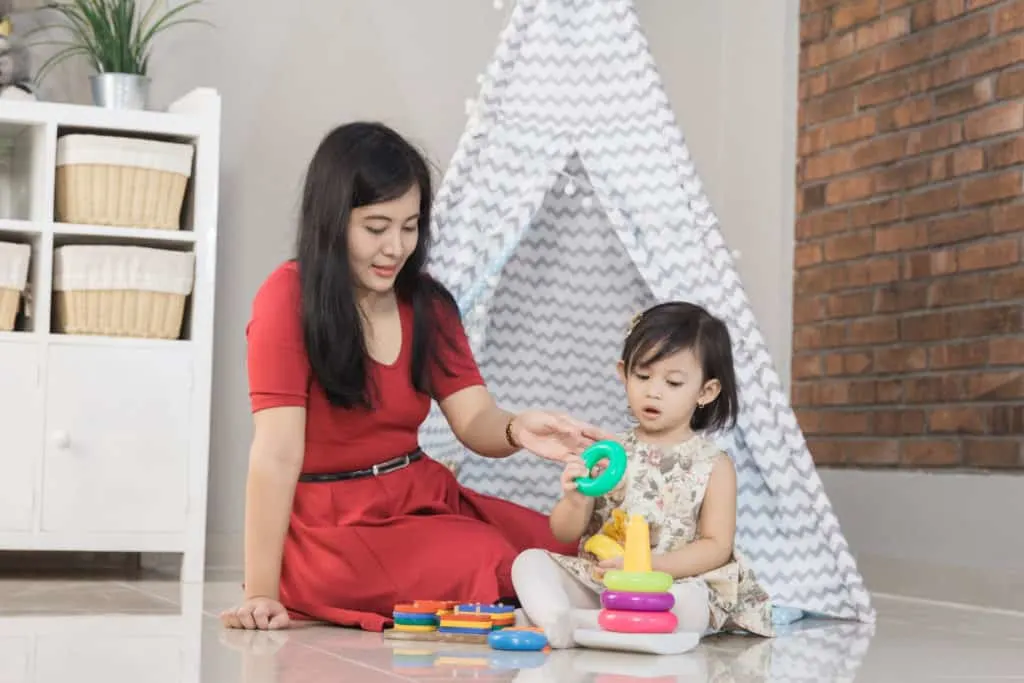
Once your child has started to master some words it is time to build on to what they say.
If you are looking at books (this book would work well) and he points and says “duck” add-on to that by repeating back “yellow duck.”
This simple strategy can be used while looking at books to help build vocabulary while engaging your young reader (read more about the benefits of early literacy.)
Try it out during a walk with your little one by talking about what you see.
If she points out the flower, add on a descriptive word such as a color or size.
Singing Encourages Communication Skills
One of the most natural ways to model and create repetition of words is through singing.
Whether it be “Itsy Bitsy Spider” or “Twinkle Twinkle” this is a simple way to engage your child in a rich language activity at any time or any place.
It doubles as a distraction if you sing to your wiggle worm while trying to change that dirty diaper.
Singing with your child is also a great way to support listening skills!
Serenade your little one on your way to the grocery store.
These are just a couple of ways to work this strategy into your day, I bet you can think of a few more!
Target Words to Increase Vocabulary
Pick target words that you want your child to learn during playtime or a daily routine.
For example, if your toddler is getting dressed you might pick the words: on, off, and socks.
Then every time your child is getting dressed you make sure to use these words consistently. This also works well when trying to teach your child a second language.
Vocabulary for Toddlers
How many words should be in your toddlers vocabulary?
All children are different so their language will come in differently.
However here are some estimates at how many words your little one should have:
15-18 Months: Uses 10-15 words
18-21 Months: Uses 15-20 words
24-30 Months: Uses 50+ words
30-35 Months: Uses 200+ words
If you have concerns about your toddlers language development make sure to consult your pediatrician or early intervention for more information.
You can also try these easy ways to communicate with non verbal toddlers to help bridge the gap before words come in.
Related Posts You Will Enjoy
Top 10 Non-Toy Gifts for Toddlers that Rock
How to Introduce Science to Your Toddler
How to Select Books Your Toddler Will Love
16 Toys that Encourage Imaginary Play
Toddler Language Development Resources
Late Bloomer or Language Problem?
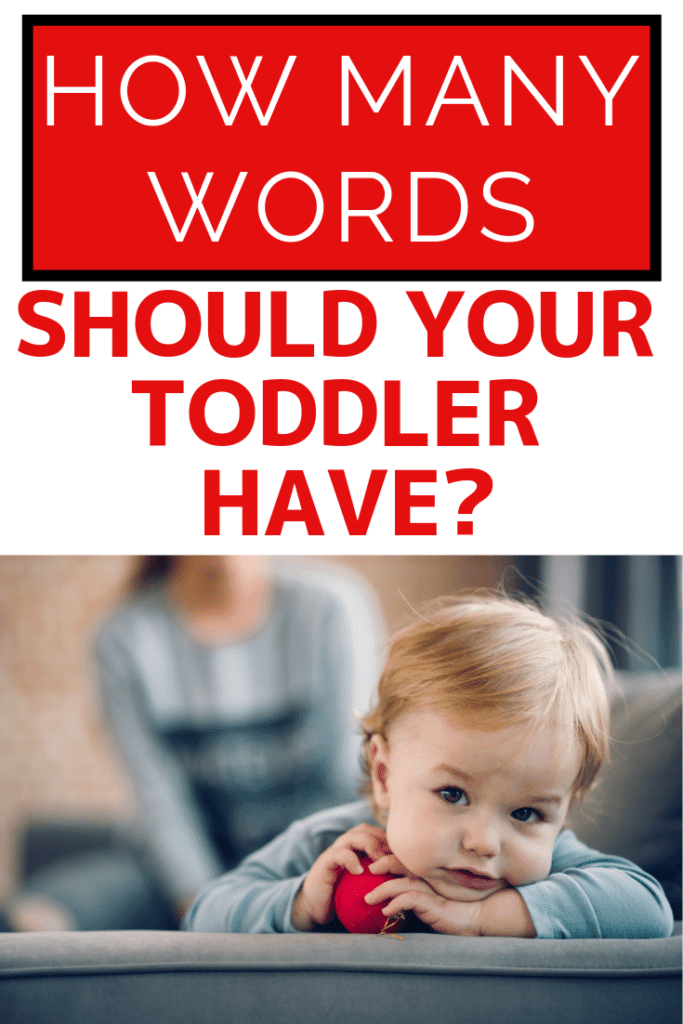

Kayla O’Neill has a master’s degree in education as well as a bachelor’s degree in special education with an emphasis in early childhood education. She has been working as a developmental therapist with babies and toddlers in early intervention since 2012. She is also a mom with two young children.
